The event streams of JavaScript are: 1. Bubbling event stream, the propagation of events is from the most specific event target to the least specific event target; 2. Capture type event stream, the propagation of events is from From the least specific event target to the most specific event target; 3. DOM event flow.

The operating environment of this tutorial: windows7 system, javascript version 1.8.5, Dell G3 computer.
1. Events
An event is a specific interaction moment that occurs in a document or browser window.
An event is a certain action performed by the user or the browser itself, such as click, load and mouseover are the names of the events.
Events are the bridge between javaScript and DOM.
If you trigger it, I will execute it - when the event occurs, its handler function is called to execute the corresponding JavaScript code to give a response.
Typical examples are: the load event is triggered when the page is loaded; the click event is triggered when the user clicks on an element.
2. Event flow
The event flow describes the order in which events are received from the page.
1. Event awareness
Question: Click on a page element, what kind of element Can you sense such an event?
Answer: When you click on an element, you also click on the container element of the element, or even the entire page.
Example: There are three concentric circles. Add the corresponding event processing function to each circle and pop up the corresponding text. When you click the innermost circle, you also click the outer circle, so the click event of the outer circle will also be triggered.
<!DOCTYPE html>
<html>
<head>
<meta charset="UTF-8">
<title></title>
</head>
<style>
#outer{
position: absolute;
width: 400px;
height: 400px;
top:0;
left: 0;
bottom:0;
right: 0;
margin: auto;
background-color: deeppink;
}
#middle{
position: absolute;
width: 300px;
height:300px;
top:50%;
left: 50%;
margin-left: -150px;
margin-top: -150px;
background-color: deepskyblue;
}
#inner{
position: absolute;
width: 100px;
height:100px;
top:50%;
left:50%;
margin-left: -50px;
margin-top: -50px;;
background-color: darkgreen;
text-align: center;
line-height: 100px;
color:white;
}
#outer,#middle,#inner{
border-radius:100%;
}
</style>
<body>
<div id="outer">
<div id="middle">
<div id="inner">
click me!
</div>
</div>
</div>
<script>
var innerCircle= document.getElementById("inner");
innerCircle.onclick= function () {
alert("innerCircle");
};
var middleCircle= document.getElementById("middle");
middleCircle.onclick=function(){
alert("middleCircle");
}
var outerCircle= document.getElementById("outer");
outerCircle.onclick= function () {
alert("outerCircle");
}
</script>
</body>
</html>The effect is as follows:
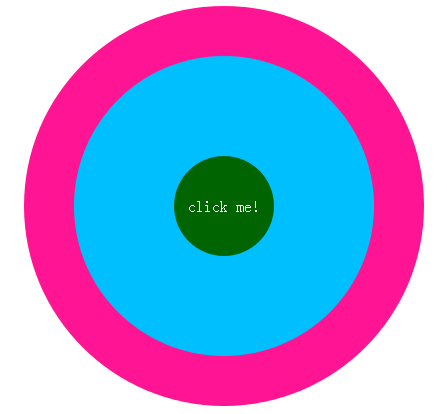
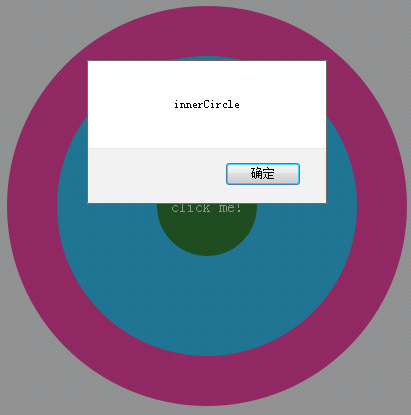
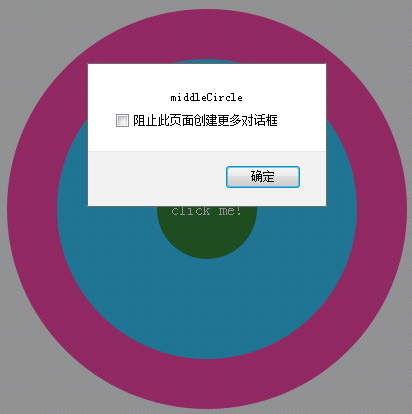
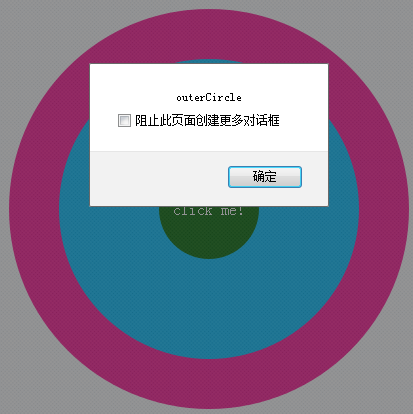
2 , event flow
When an event occurs, it will be propagated between the element node and the root node in a specific order. All nodes along the path will receive the event. This propagation process is the DOM event stream.
1), two event flow models
The order of event propagation corresponds to the two event flow models of the browser: capture event flow and bubbling event streams.
Bubble-type event flow: The propagation of events is from the most specific event target to The least specific event target. That is, from the leaves of the DOM tree to the root. [Recommended]
Captured event stream: The propagation of events is from the least specific's event target to the most specific event target . That is, from the root of the DOM tree to the leaves.
The idea of event capture is that less specific nodes should receive events earlier, and the most specific nodes should receive events last.
<!DOCTYPE html>
<html>
<head>
<meta charset="UTF-8">
<title></title>
</head>
<body>
<div id="myDiv">Click me!</div>
</body>
</html>In the above html code, the
element in the page is clicked.
The order of click event propagation in the bubbling event stream is —》—》—》document click in the capture event stream The order of event propagation is document—》—》—》 note: 1)、所有现代浏览器都支持事件冒泡,但在具体实现中略有差别: IE5.5及更早版本中事件冒泡会跳过元素(从body直接跳到document)。 IE9、Firefox、Chrome、和Safari则将事件一直冒泡到window对象。 2)、IE9、Firefox、Chrome、Opera、和Safari都支持事件捕获。尽管DOM标准要求事件应该从document对象开始传播,但这些浏览器都是从window对象开始捕获事件的。 3)、由于老版本浏览器不支持,很少有人使用事件捕获。建议使用事件冒泡。 2)、DOM事件流 DOM标准采用捕获+冒泡。两种事件流都会触发DOM的所有对象,从document对象开始,也在document对象结束。 DOM标准规定事件流包括三个阶段:事件捕获阶段、处于目标阶段和事件冒泡阶段。 )在捕获阶段不会接收事件。也就是在捕获阶段,事件从document到再到 上发生并处理。但是事件处理会被看成是冒泡阶段的一部分。 note: 1)、尽管“DOM2级事件”标准规范明确规定事件捕获阶段不会涉及事件目标,但是在IE9、Safari、Chrome、Firefox和Opera9.5及更高版本都会在捕获阶段触发事件对象上的事件。结果,就是有两次机会在目标对象上面操作事件。 2)、并非所有的事件都会经过冒泡阶段 。所有的事件都要经过捕获阶段和处于目标阶段,但是有些事件会跳过冒泡阶段:如,获得输入焦点的focus事件和失去输入焦点的blur事件。 两次机会在目标对象上面操作事件例子: 运行效果就是会陆续弹出6个框,为说明原理我整合成了一个图: 3、事件流的典型应用事件代理 传统的事件处理中,需要为每个元素添加事件处理器。js事件代理则是一种简单有效的技巧,通过它可以把事件处理器添加到一个父级元素上,从而避免把事件处理器添加到多个子级元素上。 1)、事件代理 事件代理的原理用到的就是事件冒泡和目标元素,把事件处理器添加到父元素,等待子元素事件冒泡,并且父元素能够通过target(IE为srcElement)判断是哪个子元素,从而做相应处理。关于target更多内容请参考javaScript事件(四)event的公共成员(属性和方法) 下面举例来说明。 传统事件处理,为每个元素添加事件处理器,代码如下: 事件代理的处理方式,代码如下: 2)、事件代理的好处 总结一下事件代理的好处: 3)、事件代理的问题:【update20170502】 代码如下:事件代理同时绑定了li和span,当点击span的时候,li和span都会冒泡。 解决办法: 方法一:span的事件处理程序中阻止冒泡 方法二:li的事件处理程序中检测target元素 4)、事件代理的一个有趣应用【update20170502】 点击一个列表时,输出对应的索引 【相关推荐:javascript学习教程】
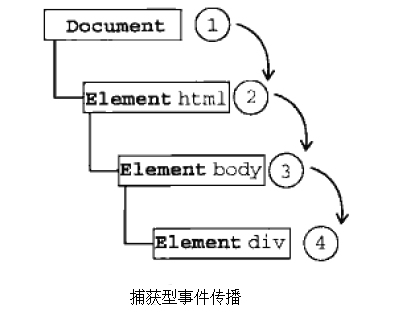

<!DOCTYPE html>
<html>
<head>
<meta charset="UTF-8">
<title></title>
</head>
<style>
#outer{
position: absolute;
width: 400px;
height: 400px;
top:0;
left: 0;
bottom:0;
right: 0;
margin: auto;
background-color: deeppink;
}
#middle{
position: absolute;
width: 300px;
height:300px;
top:50%;
left: 50%;
margin-left: -150px;
margin-top: -150px;
background-color: deepskyblue;
}
#inner{
position: absolute;
width: 100px;
height:100px;
top:50%;
left:50%;
margin-left: -50px;
margin-top: -50px;;
background-color: darkgreen;
text-align: center;
line-height: 100px;
color:white;
}
#outer,#middle,#inner{
border-radius:100%;
}
</style>
<body>
<div id="outer">
<div id="middle">
<div id="inner">
click me!
</div>
</div>
</div>
<script>
var innerCircle= document.getElementById("inner");
innerCircle.addEventListener("click", function () {
alert("innerCircle的click事件在捕获阶段被触发");
},true);
innerCircle.addEventListener("click", function () {
alert("innerCircle的click事件在冒泡阶段被触发");
},false);
var middleCircle= document.getElementById("middle");
middleCircle.addEventListener("click", function () {
alert("middleCircle的click事件在捕获阶段被触发");
},true);
middleCircle.addEventListener("click", function () {
alert("middleCircle的click事件在冒泡阶段被触发");
},false);
var outerCircle= document.getElementById("outer");
outerCircle.addEventListener("click", function () {
alert("outerCircle的click事件在捕获阶段被触发");
},true);
outerCircle.addEventListener("click", function () {
alert("outerCircle的click事件在冒泡阶段被触发");
},false);
</script>
</body>
</html>
<body>
<ul id="color-list">
<li>red</li>
<li>orange</li>
<li>yellow</li>
<li>green</li>
<li>blue</li>
<li>indigo</li>
<li>purple</li>
</ul>
<script>
(function(){
var colorList=document.getElementById("color-list");
var colors=colorList.getElementsByTagName("li");
for(var i=0;i<colors.length;i++)
{
colors[i].addEventListener('click',showColor,false);
};
function showColor(e)
{
e=e||window.event;
var targetElement=e.target||e.srcElement;
alert(targetElement.innerHTML);
}
})();
</script>
</body><body>
<ul id="color-list">
<li>red</li>
<li>orange</li>
<li>yellow</li>
<li>green</li>
<li>blue</li>
<li>indigo</li>
<li>purple</li>
</ul>
<script>
(function(){
var colorList=document.getElementById("color-list");
colorList.addEventListener('click',showColor,false);
function showColor(e)
{
e=e||window.event;
var targetElement=e.target||e.srcElement;
if(targetElement.nodeName.toLowerCase()==="li"){
alert(targetElement.innerHTML);
}
}
})();
</script>
</body>
<li><span>li中的span的内容</span></li>
<script>
$(document).on('click', 'li', function(e){
alert('li li');
});
$(document).on('click', 'span', function(e){
alert('li span');
})
</script> $(document).on('click', 'span', function(e){
alert('li span');
e.stopPropagation();
})$(document).on('click', 'li', function (e) {
if (e.target.nodeName == 'SPAN') {
e.stopPropagation();
return;
}
alert('li li');
});<script>
var ul=document.querySelector('ul');
var lis=ul.querySelectorAll('ul li');
ul.addEventListener('click', function (e) {
var target= e.target;
if(target.nodeName.toUpperCase()==='LI'){
alert([].indexOf.call(lis,target));
}
},false)
</script>
The above is the detailed content of What are the event streams in javascript?. For more information, please follow other related articles on the PHP Chinese website!
 What is thedifference between class and id selector?May 12, 2025 am 12:13 AM
What is thedifference between class and id selector?May 12, 2025 am 12:13 AMClassselectorsareversatileandreusable,whileidselectorsareuniqueandspecific.1)Useclassselectors(denotedby.)forstylingmultipleelementswithsharedcharacteristics.2)Useidselectors(denotedby#)forstylinguniqueelementsonapage.Classselectorsoffermoreflexibili
 CSS IDs vs Classes: The real differencesMay 12, 2025 am 12:10 AM
CSS IDs vs Classes: The real differencesMay 12, 2025 am 12:10 AMIDsareuniqueidentifiersforsingleelements,whileclassesstylemultipleelements.1)UseIDsforuniqueelementsandJavaScripthooks.2)Useclassesforreusable,flexiblestylingacrossmultipleelements.
 CSS: What if I use just classes?May 12, 2025 am 12:09 AM
CSS: What if I use just classes?May 12, 2025 am 12:09 AMUsing a class-only selector can improve code reusability and maintainability, but requires managing class names and priorities. 1. Improve reusability and flexibility, 2. Combining multiple classes to create complex styles, 3. It may lead to lengthy class names and priorities, 4. The performance impact is small, 5. Follow best practices such as concise naming and usage conventions.
 ID and Class Selectors in CSS: A Beginner's GuideMay 12, 2025 am 12:06 AM
ID and Class Selectors in CSS: A Beginner's GuideMay 12, 2025 am 12:06 AMID and class selectors are used in CSS for unique and multi-element style settings respectively. 1. The ID selector (#) is suitable for a single element, such as a specific navigation menu. 2.Class selector (.) is used for multiple elements, such as unified button style. IDs should be used with caution, avoid excessive specificity, and prioritize class for improved style reusability and flexibility.
 Understanding the HTML5 Specification: Key Objectives and BenefitsMay 12, 2025 am 12:06 AM
Understanding the HTML5 Specification: Key Objectives and BenefitsMay 12, 2025 am 12:06 AMKey goals and advantages of HTML5 include: 1) Enhanced web semantic structure, 2) Improved multimedia support, and 3) Promoting cross-platform compatibility. These goals lead to better accessibility, richer user experience and more efficient development processes.
 Goals of HTML5: A Developer's Guide to the Future of the WebMay 11, 2025 am 12:14 AM
Goals of HTML5: A Developer's Guide to the Future of the WebMay 11, 2025 am 12:14 AMThe goal of HTML5 is to simplify the development process, improve user experience, and ensure the dynamic and accessible network. 1) Simplify the development of multimedia content by natively supporting audio and video elements; 2) Introduce semantic elements such as, etc. to improve content structure and SEO friendliness; 3) Enhance offline functions through application cache; 4) Use elements to improve page interactivity; 5) Optimize mobile compatibility and support responsive design; 6) Improve form functions and simplify verification process; 7) Provide performance optimization tools such as async and defer attributes.
 HTML5: Transforming the Web with New Features and CapabilitiesMay 11, 2025 am 12:12 AM
HTML5: Transforming the Web with New Features and CapabilitiesMay 11, 2025 am 12:12 AMHTML5transformswebdevelopmentbyintroducingsemanticelements,multimediacapabilities,powerfulAPIs,andperformanceoptimizationtools.1)Semanticelementslike,,,andenhanceSEOandaccessibility.2)Multimediaelementsandallowdirectembeddingwithoutplugins,improvingu
 ID vs. Class in CSS: A Comprehensive ComparisonMay 11, 2025 am 12:12 AM
ID vs. Class in CSS: A Comprehensive ComparisonMay 11, 2025 am 12:12 AMTherealdifferencebetweenusinganIDversusaclassinCSSisthatIDsareuniqueandhavehigherspecificity,whileclassesarereusableandbetterforstylingmultipleelements.UseIDsforJavaScripthooksoruniqueelements,anduseclassesforstylingpurposes,especiallywhenapplyingsty


Hot AI Tools

Undresser.AI Undress
AI-powered app for creating realistic nude photos

AI Clothes Remover
Online AI tool for removing clothes from photos.

Undress AI Tool
Undress images for free

Clothoff.io
AI clothes remover

Video Face Swap
Swap faces in any video effortlessly with our completely free AI face swap tool!

Hot Article

Hot Tools

Notepad++7.3.1
Easy-to-use and free code editor

ZendStudio 13.5.1 Mac
Powerful PHP integrated development environment

Atom editor mac version download
The most popular open source editor

SecLists
SecLists is the ultimate security tester's companion. It is a collection of various types of lists that are frequently used during security assessments, all in one place. SecLists helps make security testing more efficient and productive by conveniently providing all the lists a security tester might need. List types include usernames, passwords, URLs, fuzzing payloads, sensitive data patterns, web shells, and more. The tester can simply pull this repository onto a new test machine and he will have access to every type of list he needs.

SAP NetWeaver Server Adapter for Eclipse
Integrate Eclipse with SAP NetWeaver application server.







